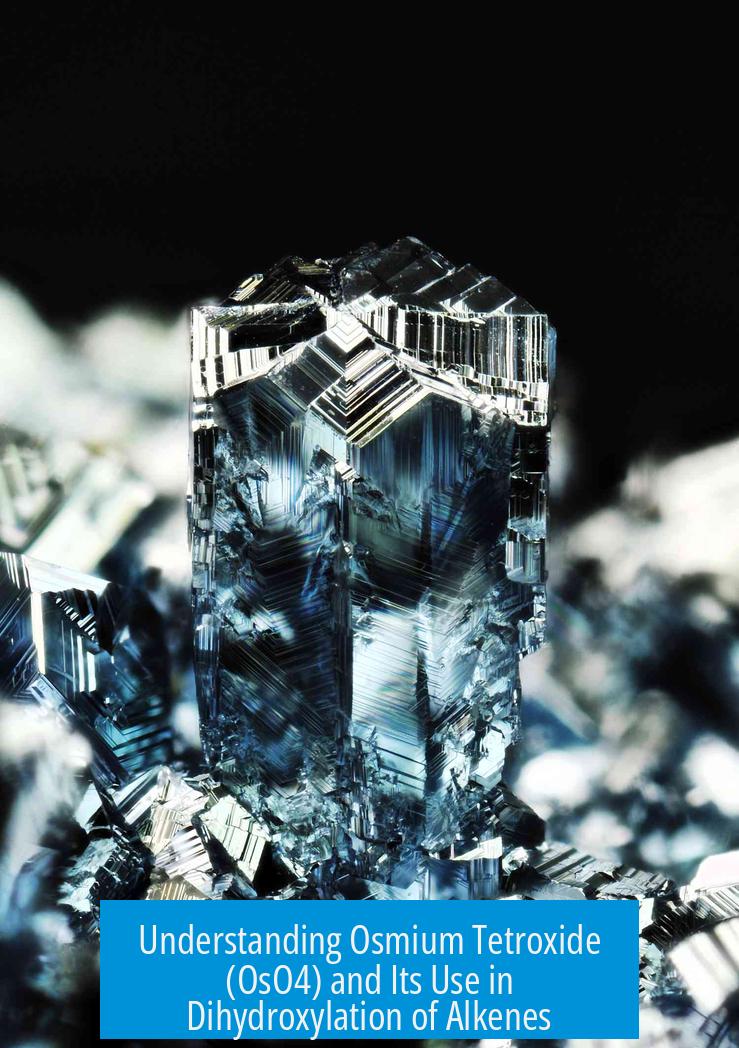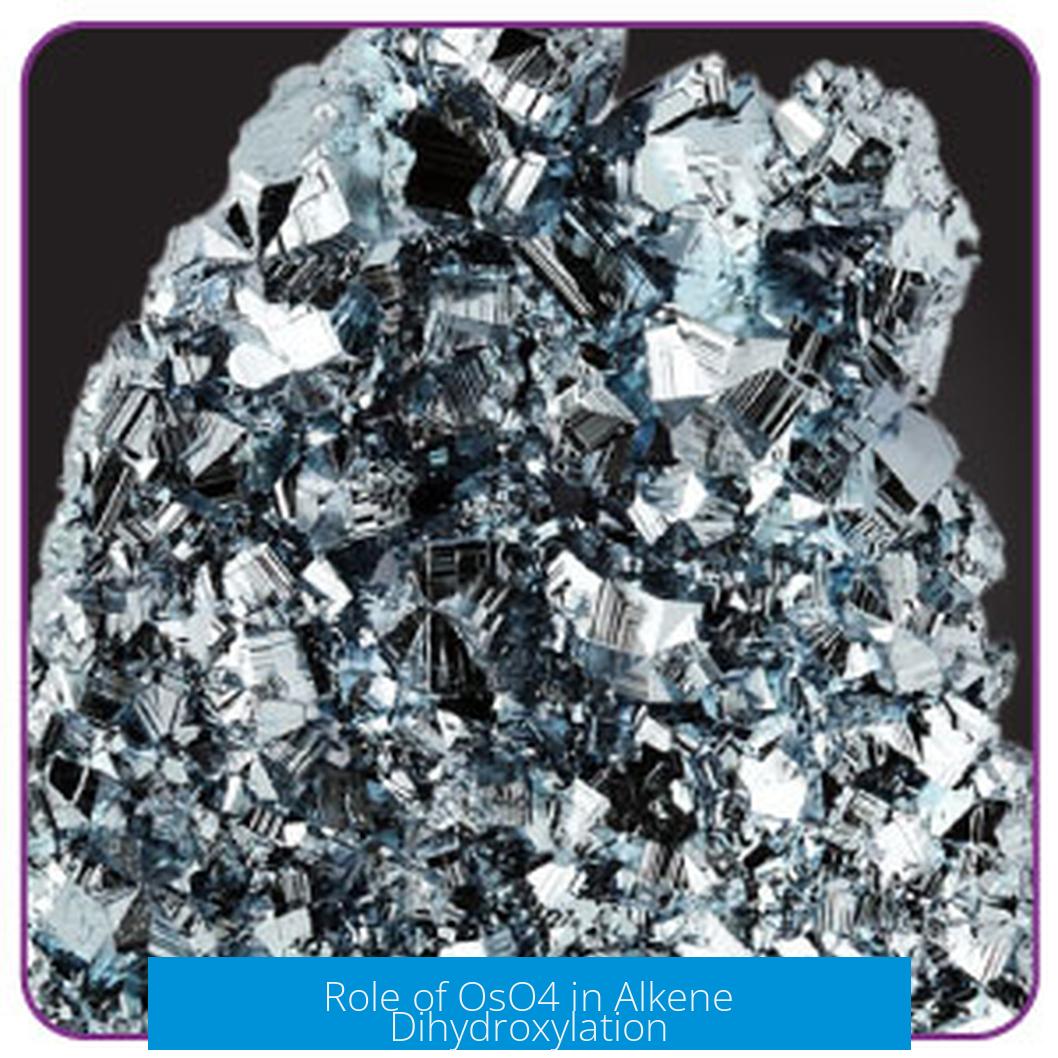Understanding Osmium Tetroxide (OsO4) and Its Use in Dihydroxylation of Alkenes

Osmium tetroxide (OsO4) is a highly toxic, volatile compound. It serves as a key reagent for the dihydroxylation of alkenes in organic synthesis. This reaction adds two hydroxyl groups across the carbon-carbon double bond of alkenes, producing vicinal diols with high regio- and stereoselectivity.
Physical and Chemical Properties of Osmium Tetroxide
OsO4 is a slightly green to colorless crystalline solid. It melts around 40°C and readily sublimates, releasing toxic vapors. The crystals are nearly transparent with just a hint of yellow-green. Its vapor and contact with surfaces quickly cause discoloration due to its strong oxidizing ability.
This compound reacts readily and vigorously on contact with organic materials, including human skin, turning it black. Such strong oxidizing power makes OsO4 both highly effective in chemistry and dangerous to handle.
Role of OsO4 in Alkene Dihydroxylation

In organic synthesis, OsO4 is prized for converting alkenes into 1,2-diols (vicinal diols) efficiently. The reaction involves syn addition of two hydroxyl groups to the alkene’s double bond, preserving stereochemistry and often giving high yield of cis-diols.
- The osmium tetroxide oxidizes the alkene by coordinating with the double bond.
- This results in a cyclic osmate ester intermediate.
- Subsequent hydrolysis releases the diol and regenerates a reduced osmium species.
- Reoxidation of osmium species with an external oxidant allows catalytic turnover.
Because of OsO4’s toxicity, it is commonly used in diluted aqueous solutions, often around 4%. These dilute forms reduce exposure risk while still delivering effective reactions.
Graduate and research chemists report using OsO4 solutions routinely to produce clean, high-purity terpene diols and other complex dihydroxylations, especially for reactions that are resistant to alternative oxidants.
Safety and Handling of Osmium Tetroxide
The major concern with OsO4 is its extreme toxicity and strong oxidizing properties. Exposure can cause severe skin discoloration, eye damage, respiratory irritation, and systemic toxicity. Its fumes feel abrasive to mucous membranes and can cause permanent injury even in small amounts.
- OsO4 vapors blacken skin on contact, a hallmark of exposure.
- Laboratory handling requires gloves, fume hoods, and sealed containers to prevent exposure.
- Waste disposal requires special procedures and professional collection to prevent environmental contamination.
Neutralization of OsO4 waste is effectively done by treatment with corn oil, which reduces the compound to less toxic species, making disposal safer.
Customary handling protocols detail intricate safety measures, including sealed vials, containment, and minimal quantities. Despite these risks, many chemists acknowledge a certain respect or privilege in working with OsO4 due to its unique chemical utility.
Additional Applications of Osmium Tetroxide
Beyond organic synthesis, OsO4 finds use in electron microscopy as a staining agent. It provides excellent contrast in biological specimens by osmication, an oxidative fixation process that enhances membrane visibility.
Its role in electron microscopy highlights OsO4’s importance beyond just synthesis, contributing to structural biology and material sciences.
Summary Table: Key Facts about Osmium Tetroxide (OsO4)
| Aspect | Details |
|---|---|
| Appearance | Colorless to slightly yellow-green crystalline solid |
| Melting Point | Approximately 40°C |
| Toxicity | Highly toxic and volatile; strong oxidizer; harmful via inhalation or skin contact |
| Chemical Use | Dihydroxylation of alkenes to produce vicinal diols |
| Reaction Type | Syn addition of hydroxyl groups across double bond |
| Common Concentrations | 4% aqueous solutions for safer use |
| Handling Precautions | Requires gloves, fume hood, sealed containers, and specialized waste disposal |
| Neutralization | Corn oil treatment |
| Other Uses | Electron microscopy staining via osmication |
Important Considerations When Using OsO4
- Always perform reactions in well-ventilated fume hoods.
- Use protective gloves and eye shields to prevent exposure.
- Store OsO4 securely to avoid contamination or accidental inhalation.
- Dispose of waste according to institutional and environmental regulations.
- Consider alternative reagents if available to reduce risk.
Key Takeaways
- Osmium tetroxide is a powerful but highly toxic oxidizer used to dihydroxylate alkenes.
- It adds two hydroxyl groups in a stereospecific manner, producing vicinal diols effectively.
- OsO4 is volatile, sublimates easily, and reacts strongly with organic materials.
- Safety is critical: proper personal protective equipment and handling protocols are mandatory.
- Neutralization using corn oil enables safer disposal of OsO4 waste.
- Besides synthesis, OsO4 is important for biological staining in electron microscopy.





Leave a Comment